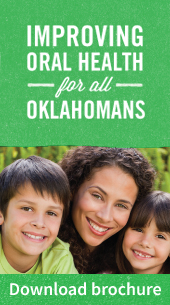Click here for printable page (pdf).
What are dental sealants?
Dental sealants are clear plastic coatings placed on a child’s permanent molars (back teeth) that seal the natural pits and grooves on the biting surface. This prevents food and bacteria from hiding in these areas, where it’s harder to reach by brushing. Studies show sealants decrease the chances of decay by more than 80 percent. School-age children without sealants have almost 3 times more cavities than those with sealants. It is important to seal the permanent molars as soon as possible after they erupt, before decay can set in.
When do permanent molars erupt?
First permanent molars come in around second grade and second molars erupt around sixth grade. This is why our program targets second and sixth grade students.
If you regularly take your child to the dentist, the dentist will simply let you know when it’s time for sealants, which are covered by Soonercare and most dental insurance plans.
Why is a school-based sealant program needed?
When a school has a high percentage of children who qualify for the Federal Free & Reduced Meal program, that tells us that many of those children are in households where the adults are working lower-paying, hourly jobs – that means they probably lack dental benefits and/or lack the opportunity to take time off to take the child for preventive dental visits. In many cases, these children won’t be taken to the dentist until they’re in pain due to decay.
A school-based sealant program utilizes portable dental clinic equipment to provide preventive services onsite at schools during the school day in order to eliminate barriers and delays.
Does it take the place of a dentist visit?
No. It is possible the child has decay that is not visible without an x-ray and full dental exam by a dentist. Parents are advised to take their child to the dentist every six months and are notified if their child’s oral health requires immediate attention.
Dental sealant and fluoride varnish help prevent cavities, but they can’t do it alone! Brushing twice a day with fluoride toothpaste, flossing once a day, eating a balanced diet, and visiting the dentist are vital to oral health.
Who does the program serve?
The program targets schools with 60 percent or higher participation in the Federal Free & Reduced Meal (FFRM) program. Students in this socio-economic status are at higher risk of dental decay and less likely to receive dental sealants.
What are the requirements for students to receive services?
The program serves every 2nd and 6th grade student at the school who returns the Permission/Health History Form signed by a parent or guardian. There are no other requirements for participation.
What services does the program provide?
Parents/guardians can approve either dental sealants or fluoride varnish treatment or both. Participating students receive a dental assessment and one-on-one oral health education.
All 2nd and 6th grade students receive toothbrush kits (not just the ones who attend the clinic).
How are sealants placed?
Applying sealants does not require drilling, shots, or x-rays. The process is short, easy, and painless. After the tooth is cleaned, a special gel is placed on the chewing surface for a few seconds. The tooth is then washed off and dried. Then, the sealant is painted on the tooth. Then the dental professional shines a “curing light” on the tooth to harden the sealant. It takes about a minute for the sealant to form a protective shield.
How long will sealants last?
A sealant can last 5 to 10 years. (Avoiding chewing extremely sticky candy and crunching on hard ice helps them last longer.) Sealants should be checked at regular dental visits and can be reapplied if they are no longer in place.
How is the program funded?
The clinics are free of charge to schools and students. The program is completely funded by Delta Dental of Oklahoma Foundation. No Medicaid or insurance reimbursement is collected.

